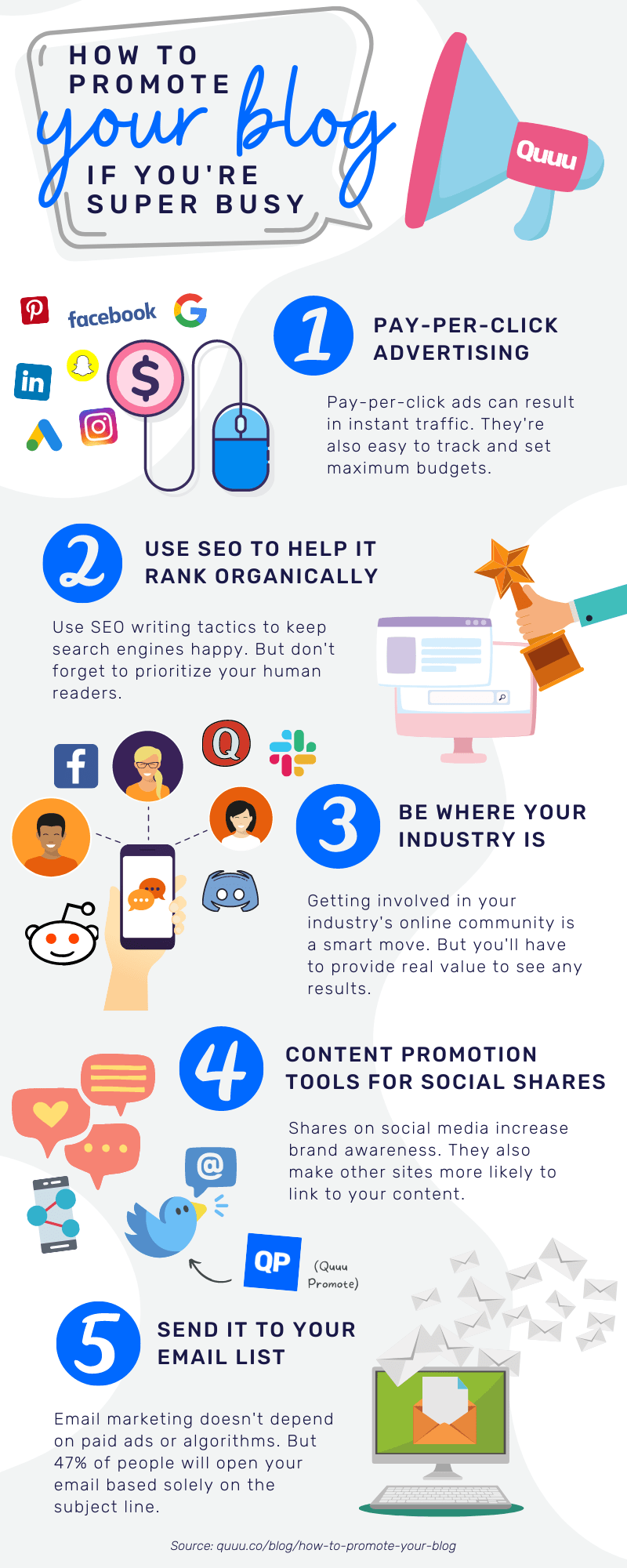Successful blogs drive traffic. And increased traffic means more potential customers. So, content marketing is a must for most industries.
Blog content can also increase brand awareness. It can even lead to guest blogging spots on sites with a higher domain rating (DR) than yours. And these all lead to backlinks to your site and other SEO goodies.
But success doesn’t come easy. Sure, you could get lucky with a viral post. But you need consistency to keep seeing results. And your content has to make people stop and notice it.
Let’s assume you’ve got the “awesome content” part nailed. Sometimes, to get eyes on your content you need extra help. There are tons of ways that bloggers promote their content. But these are some of the fastest.

The importance of promoting blog content
Why do you need to promote blog content nowadays? Well, there are so many reasons:
- Old social media algorithms were chronological
- It wasn’t as hard to rank highly on Google
- There wasn’t as much content being shared
The list goes on. Now, over 90% of all content gets no traffic from Google. None. Zilch. It’s wild. But it’s true. So, blog promotion isn’t just a nice bonus. It’s got to happen.

Partnerships and influencer relationships can help. But they take time to build.
So, here are 5 ways to promote your content if you’re super busy:
- PPC ads on social media and search engines
- Use SEO to rank organically in search engines
- Join groups of bloggers and forums in your niche
- Get hundreds of social media shares with an automated tool
- Send it out to your email list
Social media and search engine PPC advertising
Pay-per-click (PPC) ads are one of the fastest ways to promote your blog content. From LinkedIn to Facebook. All social networks now have some form of paid advertising.
You’ll also see these kinds of ads on Google. They appear at the top of SERPs (search engine ranking pages) above organic content.

They’re meant to attract targeted users to your site. Ones that’ll hopefully be interested in whatever you’re selling. If you want to grow your blog, you need people to know it’s there. That’s why these ads can be so handy.
Growth hackers love PPC ads because:
- You can get instant traffic
- It’s easy to track and measure results
- You only pay when someone clicks your ad
- It drives warm leads
- You can set a maximum budget
But there’s a catch. While the ads are easy for rookies to set up, real results are another story. Sure, you might get lucky. But if you want value for money, think about paying a professional. Especially if it’s your first time.
Creating a PPC campaign
There are tons of things to consider with PPC ads.
For example, trending content is great. But will your ad be “old news” too soon? Are you targeting certain demographics based on real data? Or are you guessing?
The stages of a PPC campaign are roughly:
- A ton of research
- Working out your budget and keywords
- Structuring your ad
- Crafting creative copy
- Updating landing pages and social media accounts
They also depend on what stage of the customer journey the user is on.

Source: Semrush
Creating an effective strategy by yourself will take time. Which might not be ideal if you’re super busy. But no matter who creates your campaign, there’s one huge thing it relies on: the quality of your content.
There’s no use in spending money to promote your blog if people won’t care when they get there. So, make sure it’s always your best work you’re putting out there.
Use SEO to rank organically in search engines
Ok, so this one technically doesn’t involve doing much after you’ve posted your content. But it’s a way to promote your blog before you’ve even started writing it.
It’s a sad fact. But almost 95% of new blog posts don’t get to the top 10 ranking on search engines in under a year. Most don’t even reach it after that. That’s a long time to wait for potentially no results from your new content.

Source: Ahrefs
Writing a guest post for a site with a high DR is likely to rank a lot quicker. Their organic traffic will also be higher because they’ve built it up over time. By including a relevant link to your blog, you’re promoting it in a way that’s providing value to the reader.
This is what Buffer did when they first started. And it’s how they grew so quickly.
The referral also signals to search engines that your blog has some authority in your industry. But outside guest posting, you need to do what you can to help it get there yourself.
SEO writing for your own blog
This is where SEO writing comes in. It’s all about how you format and structure your post to make search engines happy. And it doesn’t just include the title.
SEO writing includes things like:
- Keyword research
- Working out search intent
- Structured headings
- Link-building tactics
- Meta descriptions
If all those words meant nothing to you, check out our full blog post above. That’ll cover each term and what they mean.

Source: Cognitive SEO
70% of marketers believe SEO is more effective than PPC for driving sales. So, you know you’ve got to try it. Plugins like Yoast can help double check optimization for SEO before you publish too.

Source: Databox
But there’s something more important than all that. More than all this technical stuff. And it’s really simple. Above everything else. You need to make sure you’re writing for humans.
Creating content for humans
Google’s number one goal is to satisfy search intent. It wants its users to find the answers to their problems as quickly as possible. So, keywords are important.
But you need to answer questions with your content in an engaging way. A way that humans understand and respond to. That means creating awesome content for your target audience that’s:
- Easy to read
- Makes them feel some kind of emotion
- Gets to the point
- Includes helpful examples
If old material isn’t bringing any results, try repurposing content. If it sounds outdated, update it.
That’s why I write the way I do. Simple language. Short sentences when I can. It’s actually harder than you’d think to simplify stuff. But it gets easier the more you practice.
| Your old copywriting | Conversational copywriting |
| “With over 100 years of laundry expertise, you can trust you are in safe hands.” | “Imagine how good you’d be at something if you’d done it every day since 1908…” |
| “Flood conditions contribute to the growth and transmission of many kinds of fungi, some of which can cause sickness.” | “Be careful when cleaning up after a flood. You could get sick.” |
| “Our program has been running for three years, and we desire to better hear and interact with our beneficiaries, providers, and other stakeholders.” | “We want to hear from you!” |
Check out copywriters that are nailing conversational copy. Like Dave Harland ‘The Word Man’.
Pair all this with SEO tactics and your blog promotion strategy will take care of itself. Oh, and don’t forget to track your results and blog traffic with Google Analytics. Then you’ll see what piece of content is working and what isn’t.
Join groups of bloggers and forums in your niche
Most people like to help others out. And we can always learn new things. Even if you’re an expert in your industry. You’ll never know everything.
Promoting your blog means getting your content out there. Sure, you can add your content to sites like Flipboard or SlideShare. But there’s no human element there. And that’s what we’re relying on for this next blog promotion tactic.
Groups and forums are some of the best places to find like-minded people in your niche. Places like:
- Facebook groups
- Facebook pages
- Community sites (Quora and Reddit)
- Twitter Lists
- News sites
- Slack chats
- Discords
On Twitter, you can also use hashtags to get involved in different communities. Like #CopywritersUnite for…you guessed it. Copywriters.
Be where your industry influencers are
Basically, you’ve got to find out where people in your industry hang out. And be there too. But how you promote your blog will vary. Depending on which channel you’re on.
You can’t just post your content and expect engagement. You need to provide some kind of value.
Harry Dry explains this perfectly in his Marketing Examples newsletter. On some platforms, long-form content performs well. On others, not so much.
- Twitter and Reddit – long-form sharing with a CTA
- Facebook and Slack – visual tips with no promotion
- Social news sites – direct links

Harry also directs anyone who engages with his content to the same Twitter thread. Like he says, “One share on 50 platforms gets ignored. 50 retweets turn into 500”.

Everyone is busy these days. There’s too much content. Know how to make sure it stands out? Always be useful.
Get hundreds of social media shares with a content promotion tool
We’re now at the easiest blog promotion tactic. But first, you’ve got to know about social signals. And why they’re so important.
Social media platforms are built for mass sharing. And over half of the world’s population are using them. So, it should be a big part of your marketing strategy.

Source: Hootsuite
Engagement, notifications, and shares of your content indicates to search engines that your content is valuable. People trust it. So, then they do too.
Social shares and SEO
Shares mean visibility for your content on social media channels. And more visibility means increased brand awareness.
Now, social sharing may not be a direct ranking factor. But backlinks definitely are. And these shares can lead to people linking back to your content. So, how do we make people want to share (and promote) your blog on social media sites?
Well, blog posts don’t have to be just written content. And you need to try and create as many types as possible to engage your audience:
- A podcast series
- Video tutorials
- Webinars and interviews
- Slideshows and presentations
- Vibrant infographics

Source: William Joseph
Having social sharing buttons on your blog can definitely help. Or social bookmarking options. But you can’t guarantee people will use either of these.
So, what if there was a way to make sure people in your niche would share your content? Enter: Quuu Promote.
Quuu Promote for social backlinks
Quuu Promote is an automated content promotion tool. Well, you can opt-in to make it as automated as you want. Either way. It guarantees social shares on Facebook, LinkedIn, and Twitter.
If your site has an RSS feed, we can pick up new content automatically. If you have a WordPress blog, they create these feeds for you. Easy.

Source: Quuu
Every time you publish a blog post on your site, it’ll go straight into review. The system then checks it matches our curation guidelines. These give your content the best chance of performing well.
Everyone on our content curation platform (Quuu) has signed up to share content. They’re all real people that want relevant content for their niche. This means they’ve all got a genuine interest in what you’re creating.
If you add your Twitter handle, you can see direct mentions as and when they happen. They’re slightly harder to track with Facebook pages and LinkedIn accounts because of privacy settings. But they’re all real and all happening.
It’s never been so easy to promote your blog. Try it if you don’t believe me!
Send it out to your email list
Finally, email.
Email outreach isn’t going anywhere. Once someone’s on your list, they’re there until they choose not to be. For blog promotion and getting eyes on your content, that’s huge.
Some of the benefits of promoting your blog through email are:
- You own your list
- No need to worry about algorithms or paying for ads
- You can personalize with templates
- Email marketing tools can make it easy
- It’s easy to measure open and click rates

Source: AWeber
Now of course, you have to build this list before you can use it to promote your blog. And you may already have a customer database. If so, that’s awesome.
But what if you’re a new startup? You’ve got to make people want to hit that subscribe button, somehow. So, what do you need on your blog to reel them in?
- Great content
- CTAs (calls to action)
- Lead magnets
A lead magnet is when you give something away for free in exchange for contact details. It could be an eBook or something they can download. But that “Subscribe” button has to promise value.
Why should people sign up to emails from your blog? What do you know that they don’t? What will you bring to their day?
Creating a email newsletter
The most important part of creating an email newsletter is figuring out your goal. It can’t just be to plug your own stuff. It’s a hard truth, but customers don’t care about your product or service. They care about how it affects them.
For example, you could curate a monthly roundup of high-quality content that’s relevant to your niche. And stick your latest blog post in with it. This is a great way of making sure you’re not being too self-promotional.

Source: HubSpot
You might choose not to include your content at all in these newsletters. A purely useful email newsletter can be enough to promote your blog without even mentioning yourself.
But whichever route you choose, bear this in mind. Email subscribers can quickly jump ship if you’re spammy. So, avoid getting in touch too much.
Your subject line is also super important. 47% of email recipients will open your email based solely on the subject line.
The bottom line is: don’t just create a blog post then send it out to your email list. Learn how to promote your blog in the least “promotional” way possible.
Conclusion
If you’ve skipped through this article to find out the conclusion, you must be real busy. If you’ve made it through the full thing, kudos. The main takeaway for each of these tactics is: bring the value.
Whichever way you’re promoting your blog, people need to know there’s something in it for them. Every time.
Whether it’s through:
- PPC ads
- Organic SEO
- Groups and forums
- Content promotion tools
- Your email list
Unless it’s your friends or family, most people won’t just share everything you create for no reason. You have to make them want to. Sure you’re teaching, entertaining, or inspiring with all your content? Then you’re golden.
Have you had great results with any of these blog promotion tactics? How do you usually promote your blog? Let us know in the comment section!





